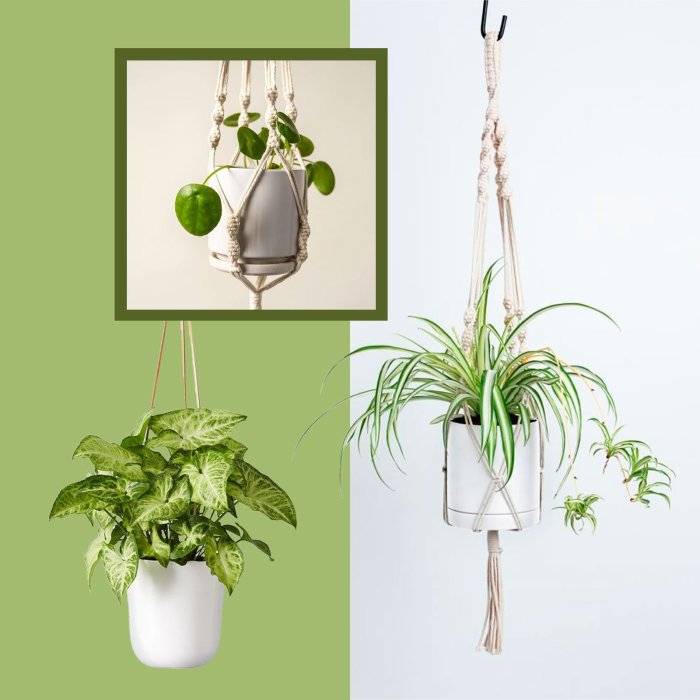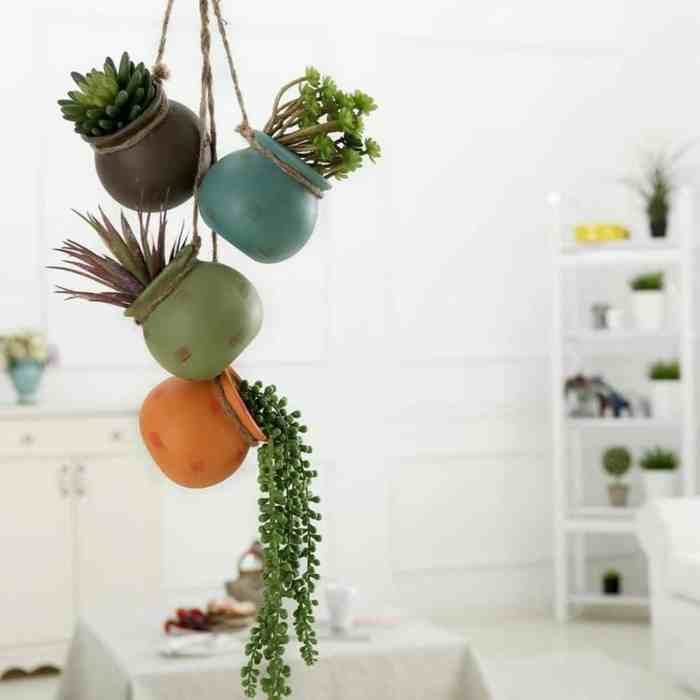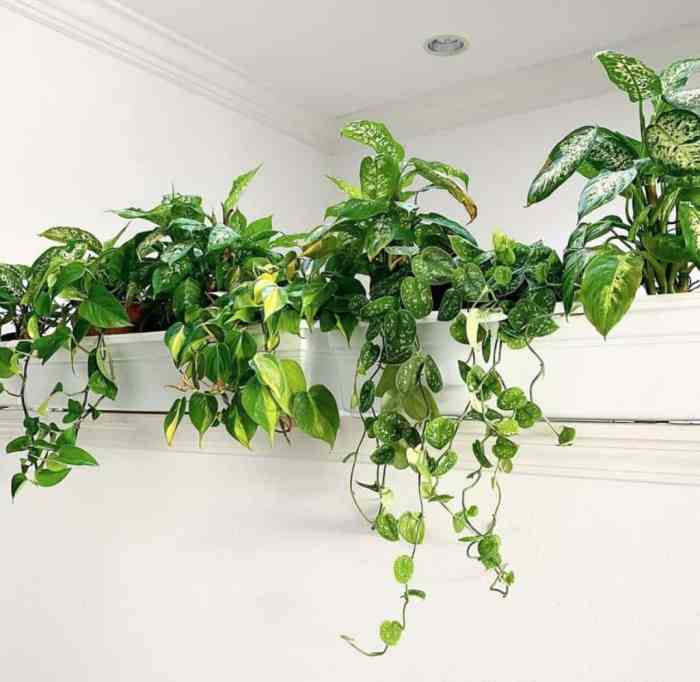With their vibrant hues and cascading foliage, colorful indoor hanging plants are a captivating way to add life and style to any space. From lush ferns to trailing succulents, these plants bring a touch of the outdoors in, creating a serene and inviting atmosphere.
In this comprehensive guide, we’ll explore the world of colorful indoor hanging plants, providing detailed care instructions, design tips, and troubleshooting advice to help you create a thriving indoor oasis.
Plant Profiles and Care Guide: Colorful Indoor Hanging Plants

Brighten up your indoor spaces with a vibrant tapestry of colorful hanging plants. From trailing vines to cascading foliage, these botanical wonders add a touch of nature and a burst of color to any room. In this guide, we explore the enchanting world of indoor hanging plants, providing detailed profiles and expert care tips to help you create a thriving indoor oasis.
Plant Profiles
When selecting indoor hanging plants, consider the size, foliage color, and specific care requirements of each species. Here are some popular options to get you started:
- String of Hearts (Ceropegia woodii): A trailing succulent with heart-shaped leaves in variegated shades of green, purple, and silver. Prefers bright, indirect light and moderate watering.
- Burro’s Tail (Sedum morganianum): A trailing succulent with plump, teardrop-shaped leaves that resemble a donkey’s tail. Requires bright, indirect light and infrequent watering.
- Spider Plant (Chlorophytum comosum): A classic indoor hanging plant with variegated green and white leaves that produce baby spider plants. Thrives in bright, indirect light and prefers moist soil.
- Pothos (Epipremnum aureum): A vigorous vine with heart-shaped leaves that come in a variety of colors, including green, yellow, and white. Tolerates low light and infrequent watering.
- Wandering Jew (Tradescantia zebrina): A trailing plant with vibrant green and purple striped leaves. Prefers bright, indirect light and moderate watering.
Hanging Basket Design and Composition

Hanging baskets are a versatile way to add greenery and color to your indoor space. They come in a variety of styles and materials, so you can find one that fits your décor. Macrame, wire, and ceramic are popular choices for hanging baskets, each offering a unique look.
When creating a hanging basket, it’s important to consider the plants you choose. You’ll want to select plants that have similar watering and light needs, and that will complement each other visually. For example, you could pair a trailing plant like ivy with a bushy plant like fern.
When arranging the plants in your hanging basket, start by placing the tallest plant in the center. Then, fill in the remaining space with smaller plants, varying the heights and textures to create a visually appealing arrangement.
Plant Combinations for Hanging Baskets, Colorful indoor hanging plants
- Trailing plants: Ivy, pothos, philodendron
- Bushy plants: Fern, peace lily, spider plant
- Succulents: Echeveria, sedum, aloe
With a little creativity, you can create a beautiful and unique hanging basket that will add life and color to your home.
Plant Wall Art and Vertical Gardens

Plant wall art and vertical gardens have emerged as innovative ways to showcase colorful hanging plants indoors, transforming living spaces into verdant oases. These creative displays utilize various techniques and materials to create captivating living walls, adding a touch of nature and freshness to home décor.
Trellises and Grids
Trellises and grids provide a structured framework for climbing plants to ascend, creating a cascading effect that adds height and depth to a room. Trellises are typically made of wood, metal, or bamboo, while grids are often constructed from wire or nylon.
Adding a touch of color and vibrancy to your indoor space? Consider incorporating colorful indoor hanging plants. These not only enhance the aesthetics but also offer air-purifying benefits. For areas with limited natural light, explore best trailing plants for low light , such as pothos, philodendron, and spider plants.
Their cascading foliage and tolerance for low light make them ideal for brightening up even the dimmest corners, bringing life and color to your indoor sanctuary.
Both options allow for flexibility in plant placement and provide ample support for trailing vines.
Colorful indoor hanging plants bring a vibrant touch to any room. For those looking to add some greenery to their indoor spaces, Bunnings offers a wide selection of hanging plants suitable for indoor environments. These plants come in various shapes, sizes, and colors, allowing homeowners to create a unique and eye-catching display that complements their décor.
With proper care and maintenance, these colorful indoor hanging plants will thrive and provide a natural touch to any living space.
Living Walls
Living walls, also known as green walls, are self-contained vertical gardens that incorporate a sophisticated hydroponic system to nourish plants without the need for soil. These systems consist of modular panels that can be customized to fit any space, providing a stunning display of lush greenery.
Living walls offer the advantage of purifying indoor air and regulating humidity levels.
Colorful indoor hanging plants bring a vibrant touch to any room, and cascading plant indoor varieties offer a unique way to add vertical greenery. Cascading plants such as pothos, philodendrons, and ferns create a lush, flowing effect, perfect for adding a touch of nature to any indoor space.
These colorful hanging plants not only add aesthetic appeal but also help purify the air and create a calming atmosphere.
Troubleshooting Common Problems

Maintaining the vibrant beauty of colorful indoor hanging plants requires vigilance and prompt attention to common issues. From yellowing leaves to infestations and diseases, understanding the causes and implementing effective solutions can ensure the health and longevity of these stunning additions to your home.
By following these troubleshooting tips, you can diagnose and resolve problems, allowing your hanging plants to thrive and bring joy to your indoor spaces.
Yellowing Leaves
Yellowing leaves on hanging plants can indicate several underlying issues, including:
- Overwatering:Excess water can suffocate roots, leading to yellowing leaves. Allow soil to dry between waterings.
- Underwatering:Prolonged dryness can also cause leaves to turn yellow. Water thoroughly when soil is dry to the touch.
- Nutrient deficiency:Yellowing between leaf veins suggests a lack of nitrogen or iron. Fertilize regularly with a balanced fertilizer.
- Chlorosis:Yellowing leaves with green veins indicate a lack of iron. Treat with an iron supplement.
Pests
Common pests that can infest hanging plants include:
- Aphids:Small, green or black insects that suck plant sap, causing yellowing leaves and stunted growth. Treat with insecticidal soap or neem oil.
- Spider mites:Tiny, spider-like creatures that weave webs on leaves, causing yellowing and leaf drop. Use insecticidal soap or a miticide.
- Mealybugs:White, cottony insects that attach to leaves and stems, causing yellowing and wilting. Treat with rubbing alcohol or horticultural oil.
- Scale:Brown or black bumps on leaves or stems that suck plant sap. Remove by hand or treat with horticultural oil.
Disease
Fungal and bacterial diseases can also affect hanging plants, leading to yellowing leaves and other symptoms:
- Powdery mildew:White, powdery growth on leaves that inhibits photosynthesis. Treat with fungicide.
- Botrytis blight:Gray mold that affects leaves and flowers, causing wilting and decay. Remove infected parts and improve air circulation.
- Root rot:Overwatering can lead to root rot, causing yellowing leaves and stunted growth. Repot in fresh soil and avoid overwatering.
End of Discussion

Whether you’re a seasoned plant enthusiast or just starting your indoor gardening journey, this guide will equip you with the knowledge and inspiration to transform your home into a vibrant sanctuary with the beauty of colorful indoor hanging plants.
Query Resolution
What are the best colorful indoor hanging plants for beginners?
Some beginner-friendly options include pothos, spider plants, and ferns.
How often should I water my colorful indoor hanging plants?
Watering frequency varies depending on the plant species, but a good rule of thumb is to water when the top inch of soil feels dry to the touch.
What are some common problems with colorful indoor hanging plants?
Common problems include yellowing leaves, pests, and overwatering. Proper care and timely troubleshooting can help prevent these issues.